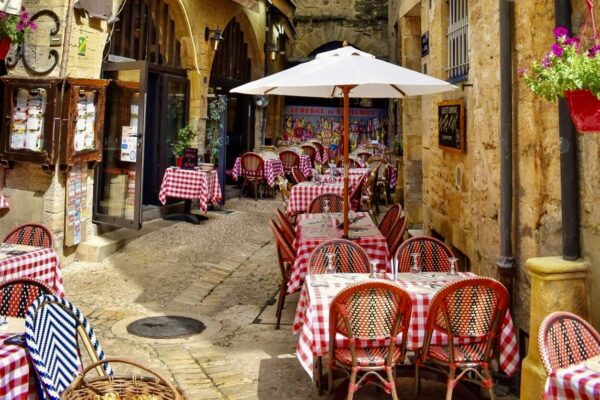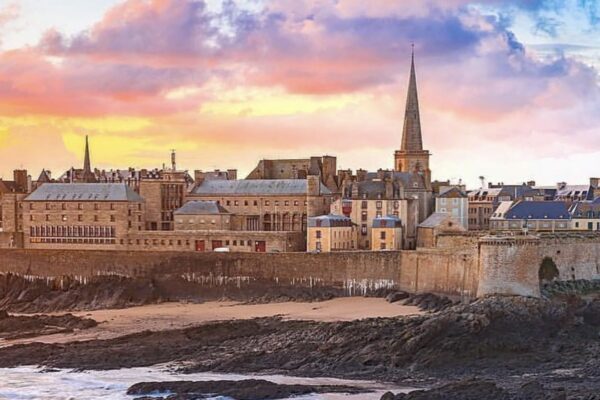Dordogne: Rocamadour, Périgueux & Sarlat-la-Canéda
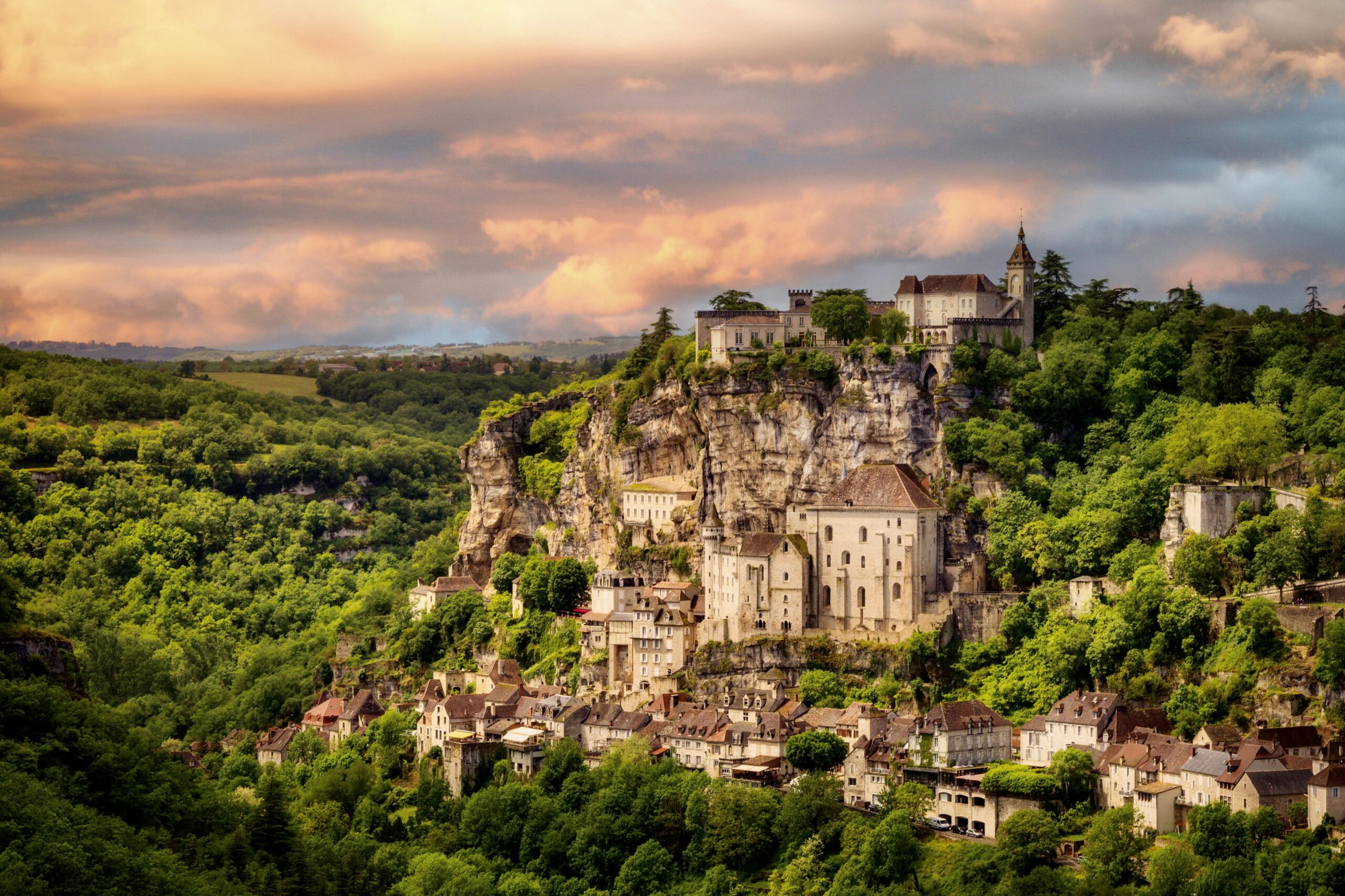
by Marla Norman & Michel Thibault
One of the most intriguing and dramatic sites in Dordogne is Rocamadour. Carved out of the mountains and suspended some 1,500 feet above the Alzou River Gorge, the village seems to defy the laws of gravity. It’s as if something miraculous keeps the place from sliding off its perch. And given that Rocamadour has been a religious site for well over 800 years, maybe something divine is at work here.
Rocamadour’s official history began in 1166 when a 1,000-year-old body was discovered “quite whole.” Needless to say, confirming the identity of the deceased at that time was challenging, much less an individual departed for over 1,000 years. Long story short, the name Amadour or “Lover” of God was chosen for the unknown person. Later, documentation seemed to link Amadour with Zaccheus, husband of Saint Veronica. Other legends describe him as the manservant of the Virgin Mary. In any case, numerous miracles began to be attributed to Amadour, who consequently became a saint, and pilgrims from across Europe began to arrive. Eventually, seven chapels were built along with an enormous basilica.
Meanwhile, back to the present…. Michel and I pull over as we approach Rocamadour to take in the site. I snap dozens of pictures, hoping to capture a decent shot of the stone marvel before us. The village itself is entirely pedestrian. As one of France’s top-ten tourist destinations and a UNESCO World Heritage Site, the medieval streets and sacred buildings are protected. And, given the number of tourists who visit annually, hundreds of vehicles adding to the congestion would be catastrophic. Fortunately, ample parking is available at the base of the village and tourist trains conveniently transport passengers up and down the mountain all day long.
Once we make it to the village, our first destination is Le Terminus des Pélerins – a restaurant featuring all the local specialties: Cassoulet au Confit de Canard (Duck Casserole), L’agneau du Quercy (Quercy Lamb), Chèvre Cheese from Rocamadour and Gateau aux Noix (Walnut Pie) — suffice it to say that this meal and the incredible hilltop views confirm Rocamadour’s heavenly status.
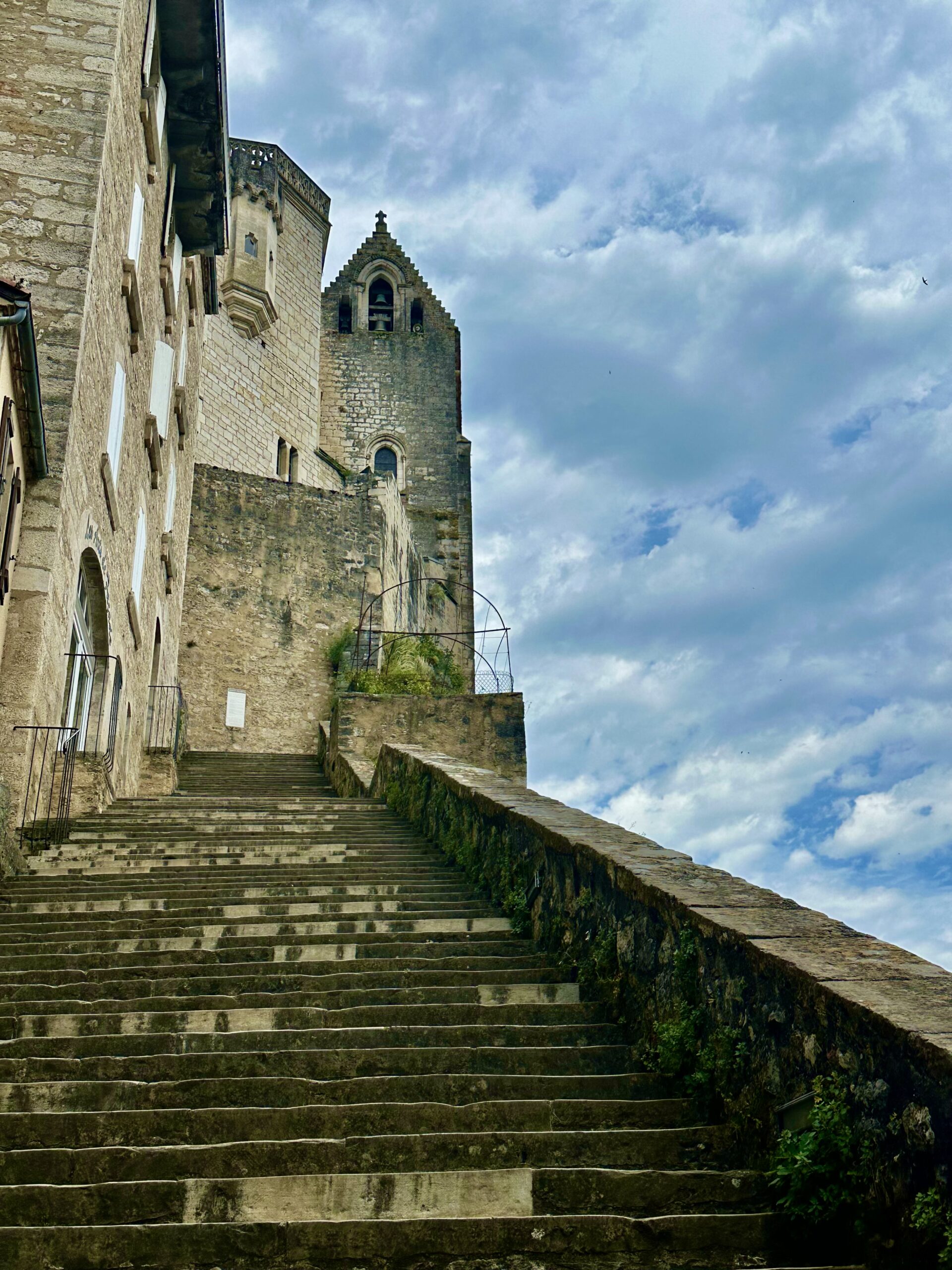
A daunting view – 216 steps to the top of Rocamadour and the Basilica Saint-Sauveur. Photo by Marla Norman.
Fortified by the hearty lunch, we decide to take the 216 steps to the Basilica. Standing at the base of the stairs we can’t imagine how pilgrims once made the climb on their knees. Fortunately at that same moment, we spot a sign for elevators — Divine Providence, obviously.
We arrive at Place Saint-Amadour and its seven chapels. Chapelle Notre-Dame is open, so we’re able to see the church with its three walls ingeniously carved out of the cliff. The chapel also houses the famous Black Madonna. Dating from the 12th century, the tiny statue is a mere 27 inches tall, with a blackened patina from centuries of candle smoke and oxidation. Miracles are also attributed to the Madonna and a mysterious bell hanging in the chapel is said to ring each time a prayer is answered.
Nearby is Chapelle Saint-Michel also, astonishingly, built into the cliffs. Two beautifully preserved 12th century frescoes adorn the interior: the Annunciation and Visitation. Other frescoes portray Saint-Christophe and the Archangel Saint-Michel.
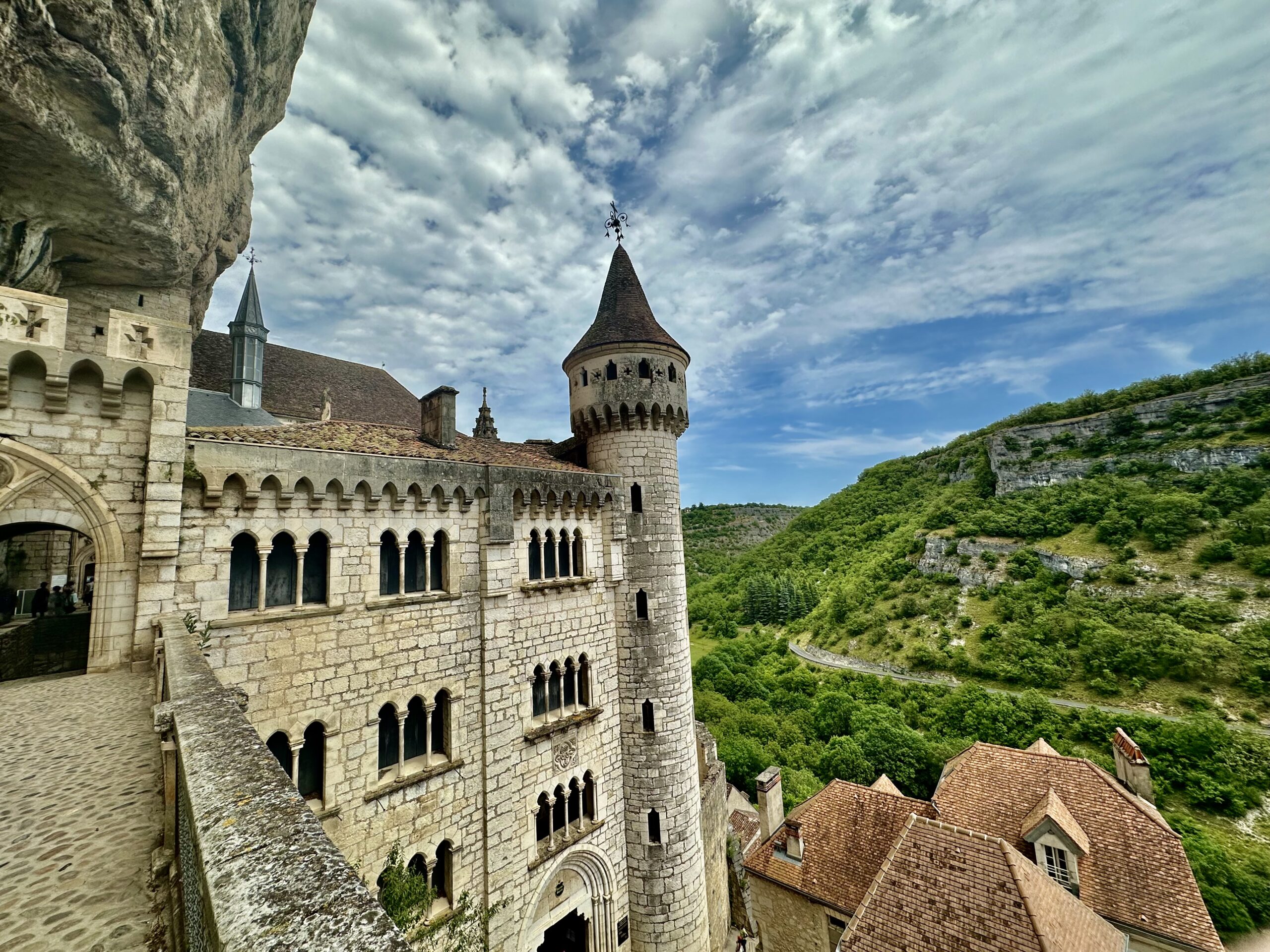
Heart stopping views of Chapelle Saint-Michel built into the cliffs. Photo by Marla Norman.
Here too is the legendary Durandal, an iron sword that supposedly belonged to Roland, a knight of Charlemagne. Similar to the Excalibur sword of Arthurian tales, Durandal can cut through stone with a single blow. During the Battle of Roncevaux, as Saracens attacked, Roland threw the weapon to prevent its being seized by the enemy. Incredibly, the sword traveled hundreds of miles and embedded here in the cliffs of Rocamadour. Astounding!
After visiting the chapels and basilica, we’re inspired by the centuries of devotion and the magnificent views, but the sightseeing we’ve done and the number of miracles we’ve encountered has left us a bit lightheaded and footsore.
Unfortunately, the elevator we took up has now closed, so we maneuver down the 216 steps…very slowly… Back in the main village, we grab the last train and head out, watching Rocamadour fade into misty clouds — half rock, half ephemera — truly a castle in the air.
SARLAT-LA-CANÉDA
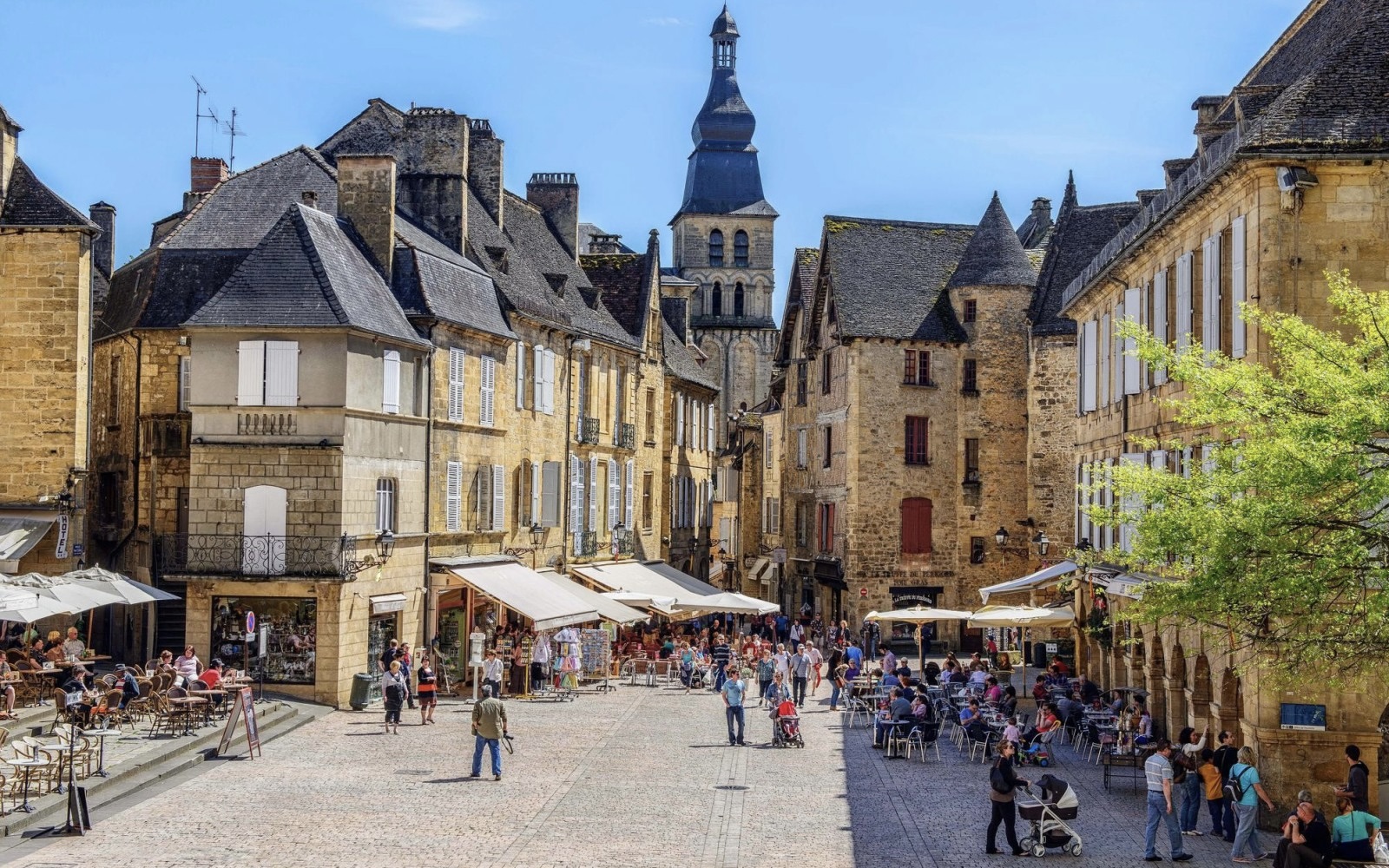
Place de la Liberté in Sarlat-la-Canéda. Photo courtesy of Périgord Tourisme.
During the Hundred Years War, the citizens of Sarlat-la-Canéda remained singularly loyal to the French King Charles VII. Grateful for their enduring support, the King rewarded Sarlat with a number of royal privileges. As a result, a new prosperous merchant class was established and the village was rebuilt. Elegant stone buildings and half-timbered houses with slate roofs were constructed. Many of the villages in the Dordogne look as if they were pulled from the pages of a fairy tale, but Sarlat may very well be the loveliest.
The city can definitely boast having the largest number of protected historic buildings — 77 in all. In fact, Sarlat holds the record for the highest number of historic sites in France. Moreover, the village center, where most of the buildings are located, is a UNESCO World Heritage Site.
And, Sarlat can also claim to be one of France’s top locations for movie production. Many of the 45-plus films that have been produced here are documentaries or historical epics, but others — most famously “Chocolat” starring Johnny Depp and Juliette Binoche showcase Sarlat’s romantic settings. The town even hosts an annual film festival in November.
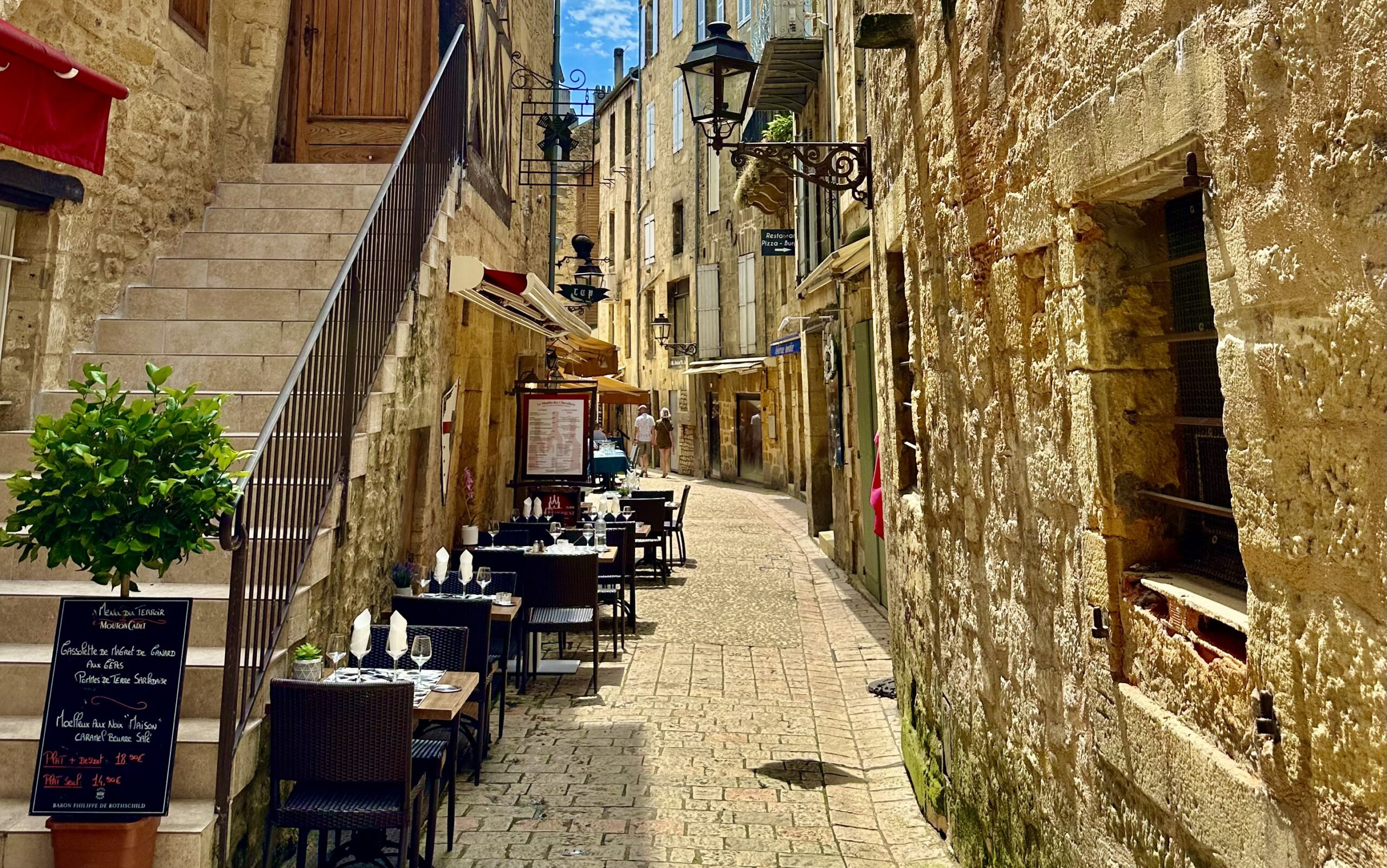
The romantic streets of Sarlat have served as the backdrop for many films, including “Chocolat”. Photo by Marla Norman.
We begin our visit at Cathédrale Saint-Sacerdos — originally built in the 12th century, reconstruction of the cathedral was undertaken in 1504. The interior sanctuary is quite simple and relatively small. Beautifully preserved stained glass windows line the walls.
Behind the cathedral is another of Sarlat’s most famous landmarks – Lanternes des Morts (Lanterns of the Dead). The original function of this tower constructed in the 12th century by the Knights Templar (possibly), is unknown. Some historians believe the tower was originally called Lanterns des Maures (Lanterns of the Moors) because lights were hung to warn villagers of attacks. Others maintain that the tower is connected to a nearby cemetery. What we can verify is that the views over the rooftops of Sarlat from this vantage point are magnificent!
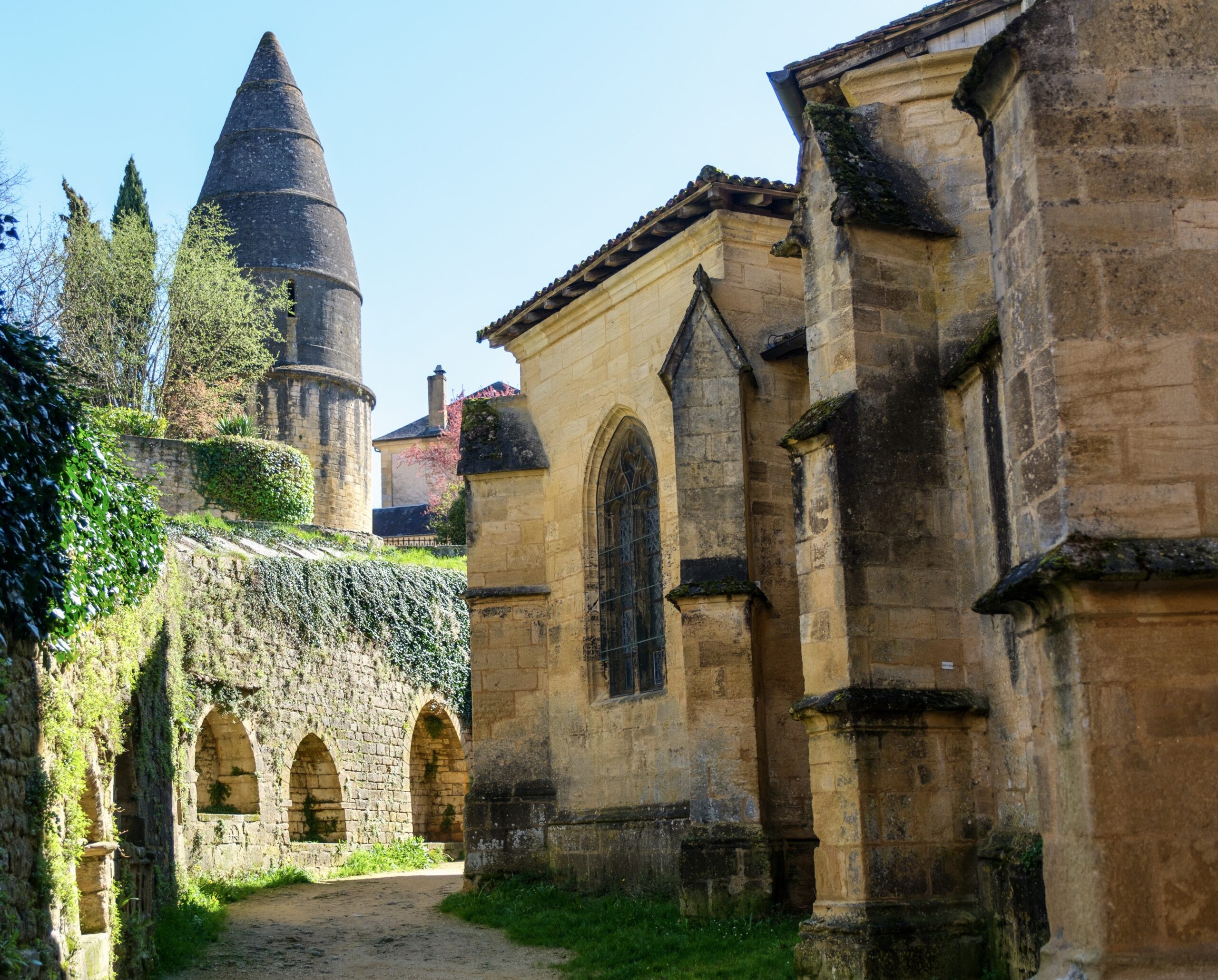
One of Sarlat’s most famous landmarks – Lanternes des Morts (Lanterns of the Dead).
Opposite the town hall and overlooking Place du Marché aux Oies (Goose Market Square) the former Gothic church of Sainte-Marie has been redesigned to become the town’s covered food hall. The hall is open daily – except for Thursdays. Saturday is the big market day, with stalls winding through the village. Michel and I walk through the hall, swooning over the delicious aromas and mouth-watering produce, cheeses, homemade confiture (jellies & preserves), pastries and lots and lots of truffles. Later we take a break and ride the elevator to the top of the Marché to see the 360-degree views — breathtaking!
Needless to say, after visiting the market (and purchasing a few treats to take back home) we are ravenous. Our next and final stop in Sarlat is Le Bistro de L’Octroi. The restaurant, located at the entrance of Sarlat, was once a tax house. Open every day for lunch and dinner, the bistro serves up a seasonal menu — extremely well-priced. The daily Menu du Marché is typically 20 € (!!!).
We start with house made Foie Gras, which simply melts in our mouths, then we enjoy a Papillote de Poisson and pasta with truffles. Dessert was particularly memorable — a Soufflé aux Noix (Walnut Soufflé) with a walnut liqueur sauce. Unctuously rich and luscious. The perfect ending to our day in Sarlat!
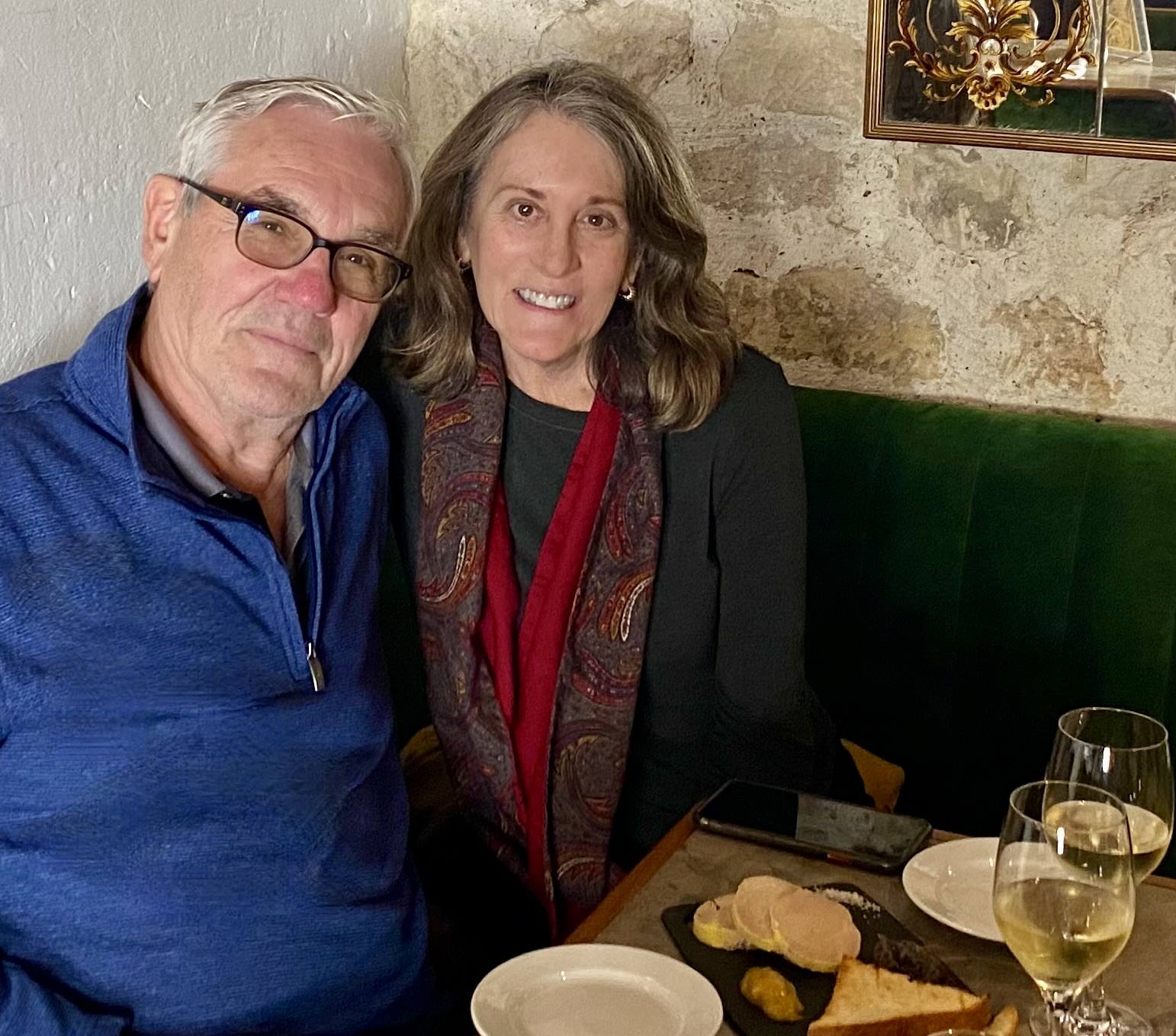
More Foie Gras! Dining in Dordogne is always memorable.
PÈRIGUEUX
Marla and I spend the last day of our Dordogne tour in Périgueux, the capital of the region and vastly different from the storybook villages we’ve been visiting. This is a real urban center, lots of stylish shops and boutiques. And, as good as the food scene is in the other parts of Dordogne, Périgueux has it all. The markets here are some of the best in France.
But our first stop is Cathédrale Saint-Front. Long associated with the pilgrimages to Santiago de Compostela, the cathedral was consecrated in 1173 and then redone in the 19th century by architect Paul Abadie, famous for designing the Sacré-Cœur in Paris. Interesting to know, because the second you see Saint-Front you are struck with the similarity between the two churches.

Périgueux’s Cathédrale Saint-Front was remodeled in the 19th century by Paul Abadie, famous for designing the Sacré-Cœur in Paris. Photo by Marla Norman
Near the Cathedral are the markets on Place du Coderc wich are open on Wednesday and Saturday. There is Foie Gras, of course, but also truffles, strawberries, walnuts, cheese, Cepes mushrooms. The stars of the show are the breads and pastries. There are also side markets featuring housewares and clothing but most everyone hangs around the food stalls…smart people!
Black Truffles often referred to as Black Diamonds are unmistakable. Their pungent flavors can alter the taste of a dish and make it divine. Many folks believe truffles are only a specialty of Piemonte, Italy and we will let them keep on believing that so we don’t run out of this delicacy in Dordogne. Dogs, not pigs are digging up truffles these days. Do beware of scams with truffles. Fresh ones are gathered from December through February only.
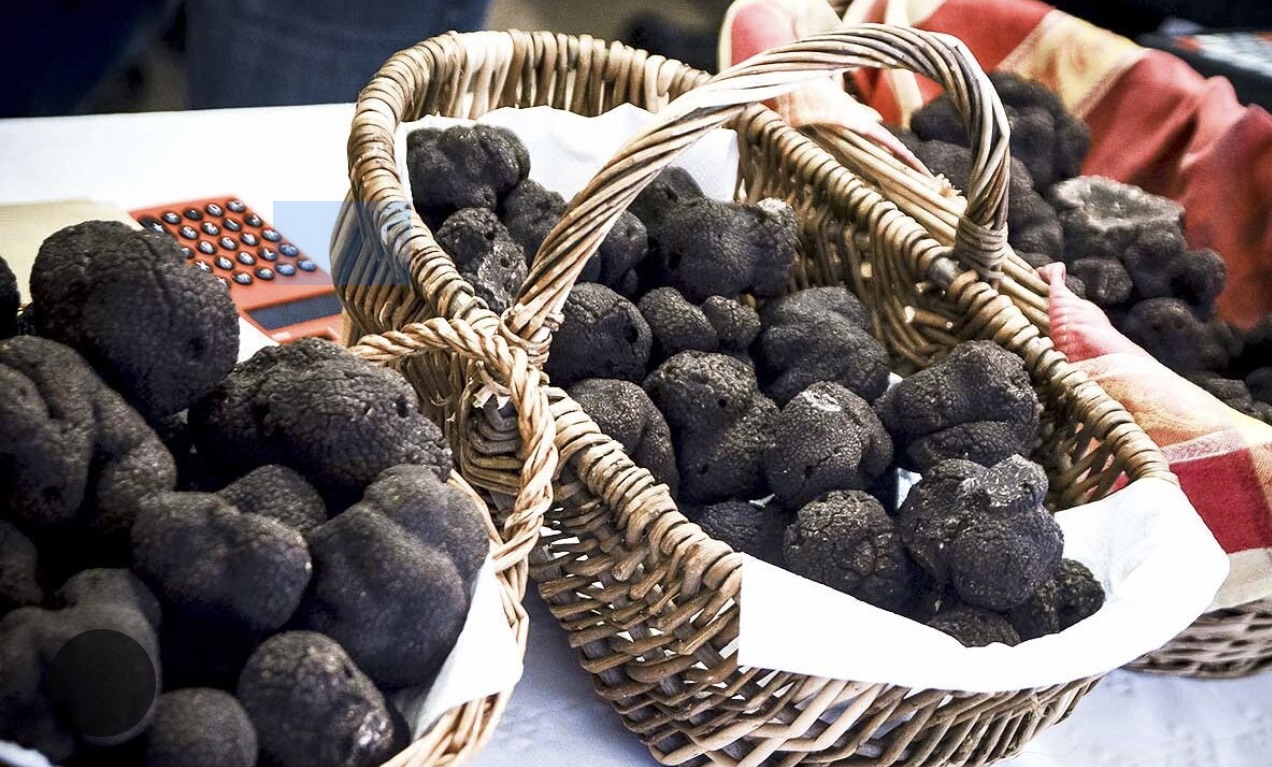
Black Truffles – worth their weight in gold (literally!) are plentiful in the Périgueux.
Ceps Mushrooms or “Cepes” in French are another don’t miss food. These mushrooms are usually available in September-October as they require hot, humid days and cool nights. Cepes have a fabulous, meaty, earthy flavor and are often pan-sautéed on their own or with a touch of garlic. YYYUUUUMMM
Walnuts are also plentiful and stalls are loaded with them. Another September product, it has to be shipped before mid-October to earn the AOC (proof of quality) label! The Perigord walnuts are rich in flavor and their creaminess adds to many wildlife dishes. The Dordogne, with its clay-limestone soils is an ideal location for walnut trees.
Foie Gras is sold either “entier” (complete) or as a bloc. Pâté is the inexpensive version, mixed with pork. The bloc is lobes that are emulsified with water and served “en torchon” (in a cloth) while the entier is what you delicately and swiftly sauté, usually deglazed with Sauternes or Monbazillac sweet wine. Sorry for the poor geese and ducks but the taste of Foie Gras can be an addiction…
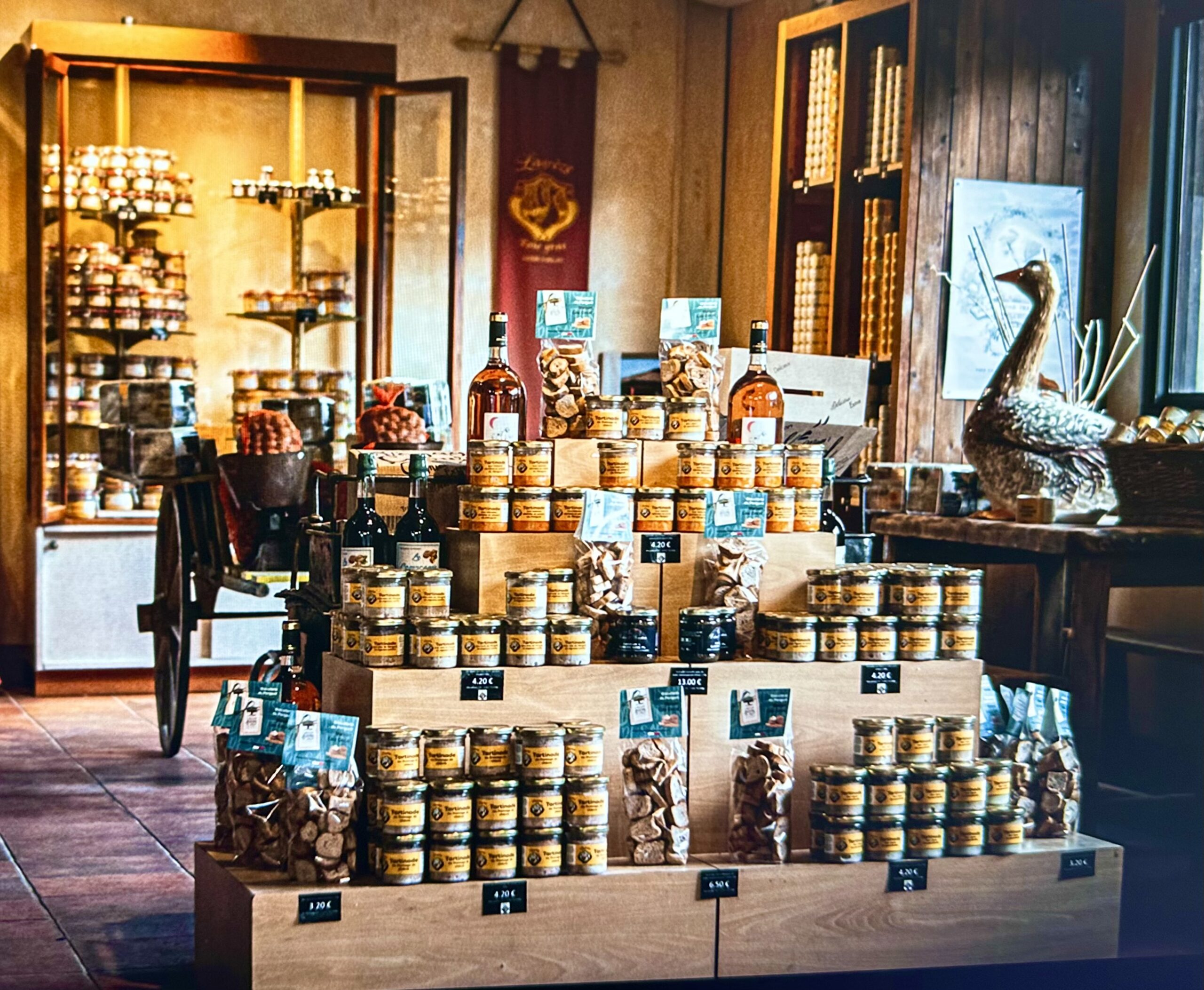
Enticing display of Périgord Foie Gras at La Maison Lagrèze. (Available online as well)
Cabecou Cheese is my favorite food of Perigord. This small round cheese (only a few ounces) is made from goat milk. It is soft in texture, consumed young on a slice of bread. Its flavor is a combo of butter and hazelnuts. Speaking of bread, when in Perigueux, try the Croustilot, an old fashioned round loaf made with the finest wheat. Croustilot is a tradition that is disappearing so taste it while you can.
For sweets, don’t miss out on Gateau de Noix (walnut cake), Pompe aux Pommes du Perigord (apple and almonds in flaky pastry) but mostly fill up on the most wonderful strawberries you have ever tasted. Not filled with water as unfortunately is often the case in our US supermarkets, but small, dense, fleshy and flavorful. At room temp, these will last 4-5 days (not in our hotel room, they were gone in minutes.)
The Périgueux market is a feast for our eyes, nose and mouth. What a pleasure to see real food in a natural state. Yes, Dordogne castles are imposing, the river is majestic, and the villages are quaint, rustic and steeped in history. But when it’s all said and done, leave us at a dining room table anywhere in the region!

The famous Périgueux markets are open every Wednesday and Saturday. Photo by Marla Norman
Click here for more on our travels in Dordogne or you might be interested in the medieval fortress Carcassonne, dating back to 100 BC.




